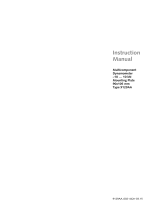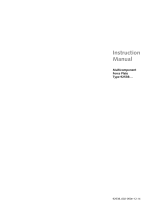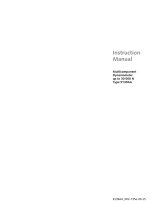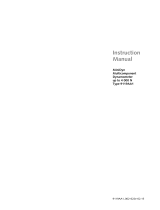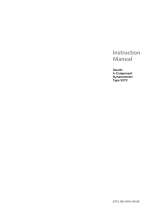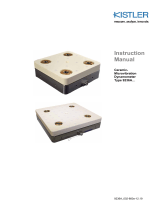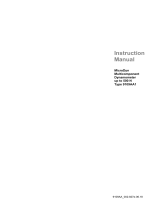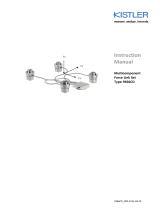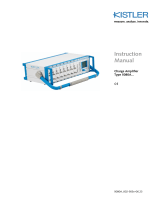
Instruction
Manual
Quartz 3-Component
Dynamometer
Type 9257B
…
9257B_002-054e-03.15

Instruction
Manual
Quartz 3-Component
Dynamometer
Type 9257B…
9257B_002-054e-03.15


Foreword
Page 1 9257B_002-054e-03.15
Foreword
Information in this document is subject to change without
notice. Kistler reserves the right to change or improve its
products and make changes in the content without
obligation to notify any person or organization of such
changes or improvements.
©1991 … 2015 Kistler Group. All rights reserved. Except as
expressly provided herein, no part of this manual may be
reproduced for any purpose without the express prior
written consent of Kistler Group.
Kistler Group
Eulachstrasse 22
8408 Winterthur
Switzerland
Tel. +41 52 224 11 11
Fax +41 52 224 14 14
www.kistler.com

Quartz 3-Component Dynamometer Type 9257B…
Page 2 9257B_002-054e-03.15
Content
1. Introduction ................................................................................................................................... 4
2. Important Information .................................................................................................................... 5
2.1 For Your Safety .................................................................................................................... 5
2.2 How to Treat the Instrument ................................................................................................ 6
2.3 Tips for Using the Instruction Manual .................................................................................. 7
2.4 What Happens after Modifications? ..................................................................................... 7
3. General Description of the Instrument ........................................................................................... 8
3.1 What Does a Multicomponent Dynamometer Do? .............................................................. 8
3.2 Functional Principle .............................................................................................................. 9
3.3 Design of the Dynamometer .............................................................................................. 10
4. Assembly, Installation and Putting into Operation ...................................................................... 11
4.1 Important Remarks ............................................................................................................. 11
4.2 Assembling the Dynamometer ........................................................................................... 11
4.3 Dynamometer Positioning .................................................................................................. 12
4.4 Basic Circuitry and Cabling of the Measuring System ......................................................... 12
4.4.1 Force Measuring with 3 Components (Fx, Fy, Fz) .................................................... 13
4.4.2 3-Component Force Measurement ........................................................................ 14
4.4.3 Force and Moment Measuring with 6 Components (Fx, Fy, Fz, Mx, My, Mz) ............ 15
5. Operation ..................................................................................................................................... 17
5.1 Range Selection .................................................................................................................. 17
5.2 Measuring Small Force Changes ......................................................................................... 17
5.3 Usable Frequency Range .................................................................................................... 19
5.4 Temperature Influences ...................................................................................................... 21
5.5 Polarity of the Measuring Signal ......................................................................................... 21
6. Maintenance ................................................................................................................................ 22
6.1 Recalibrating the Instrument .............................................................................................. 22
6.2 Maintenance Tasks ............................................................................................................. 23
7. Trouble Shooting ......................................................................................................................... 24
7.1 Tracing Faults and Remedying Them .................................................................................. 24
7.2 Defective Dynamometer .................................................................................................... 25

Content
9257B_002-054e-03.15 Page 3
8. Technical Data .............................................................................................................................. 26
8.1 3-Component Dynamometer Type 9257B… ...................................................................... 26
8.2 Accessories .......................................................................................................................... 28
9. Annex ........................................................................................................................................... 29
9.1 Glossary .............................................................................................................................. 29
9.2 Measurement Uncertainty .................................................................................................. 33
9.3 Linearity .............................................................................................................................. 34
9.4 Frequency Range ................................................................................................................ 36
9.5 Influence of Temperature .................................................................................................... 37
Total Pages 38

Quartz 3-Component Dynamometer Type 9257B…
Page 4 9257B_002-054e-03.15
1. Introduction
Please take the time to thoroughly read this instruction
manual. It will help you with the installation, maintenance,
and use of this product.
To the extent permitted by law Kistler does not accept any
liability if this instruction manual is not followed or
products other than those listed under Accessories are
used.
Kistler offers a wide range of products for use in measuring
technology:
Piezoelectric sensors for measuring force, torque, strain,
pressure, acceleration, shock, vibration and acoustic-
emission
Strain gage sensor systems for measuring force and
moment
Piezoresistive pressure sensors and transmitters
Signal conditioners, indicators and calibrators
Electronic control and monitoring systems as well as
software for specific measurement applications
Data transmission modules (telemetry)
Kistler also develops and produces measuring solutions for
the application fields engines, vehicles, manufacturing,
plastics and biomechanics sectors.
Our product and application brochures will provide you
with an overview of our product range. Detailed data
sheets are available for almost all products.
If you need additional help beyond what can be found
either on-line or in this manual, please contact Kistler's
extensive support organization.

Important Information
9257B_002-054e-03.15 Page 5
2. Important Information
2.1 For Your Safety
This instrument has been tested thoroughly and it left
the works in a perfectly safe condition. To maintain this
condition and assure safe operation, the user must
observe the directives and warnings contained in these
instructions.
The dynamometer must be installed, operated and
maintained only by persons who are familiar with it and
adequately qualified for their particular tasks.
When it must be assumed that safe operation is no
longer possible, the instrument must be taken out of
operation and secured against unintentional use.
It must be assumed that safe operation is no longer
possible if:
the instrument is visibly damaged,
it no longer functions,
it has been in lengthy storage under adverse
conditions,
it has received rough treatment during transport.
Important!
For measuring cutting forces, fix the dynamometer on the
machine tool according to the instructions. See section 4.2.
"Assembling the dynamometer" for details.
Important!
Fix all parts mounted on the top plate of the
dynamometer according to the forces expected.

Quartz 3-Component Dynamometer Type 9257B…
Page 6 9257B_002-054e-03.15
2.2 How to Treat the Instrument
The dynamometer may be used only under the
specified environmental and operating conditions.
The insulation resistance is crucially important with
piezoelectric measurements. It must be around 1014 Ω
(but at least 1013 Ω). To obtain this resistance, all plug
and socket connections must be kept meticulously clean
and dry. The insulation resistance can be measured with
the insulation tester Type 5493.
Protect the signal output against dirt and do not touch
it with your fingers.
When the connection is not being used, cover it with
the cap provided.
The connecting cable from dynamometer to charge
amplifier is highly insulating. Use only the proper cable.
Use only specified connecting cable.
Do not remove the connecting cable from the
dynamometer.
When the dynamometer is not in use, protect it by
keeping it in the packing case supplied.
When performing long-time measurements, make sure
that the temperature of the dynamometer remains as
constant as possible.

Important Information
9257B_002-054e-03.15 Page 7
2.3 Tips for Using the Instruction Manual
We recommend reading the entire Instruction Manual as a
matter of principle. If you're in a hurry, however, and
you've already gathered experience with Kistler
dynamometers, you can confine your reading to the
information that you really need.
We have endeavoured to arrange these instructions so that
you can find the information you need without difficulty.
Please keep these Operating Instructions in a safe place
where they can be consulted any time.
If the instructions get lost, just turn to your Kistler customer
service station and they will be replaced without delay.
All information and directives in these instructions may be
modified at any time without prior notification.
2.4 What Happens after Modifications?
Modifications to instruments result in alterations of the
operating instructions as a rule. In such cases, enquire at
your Kistler customer service station about the possibilities
of updating your documentation.

Quartz 3-Component Dynamometer Type 9257B…
Page 8 9257B_002-054e-03.15
3. General Description of the Instrument
3.1 What Does a Multicomponent Dynamometer Do?
The multicomponent dynamometer provides dynamic and
quasi-static measurement of the 3 orthogonal components
of a force (Fx, Fy, and Fz) acting from any direction onto the
top plate.
With the aid of optional evaluation devices the 3 moments
Mx, My and Mz can be measured as well.
The dynamometer has high rigidity and hence high natural
frequency. The high resolution enables very small dynamic
changes to be measured in large forces.
The dynamometer measures the active cutting force
regardless of its application point. Both the average value
of the force and the dynamic force increase may be
measured. The usable frequency range depends mainly on
the resonance frequency of the entire measuring rig.
Fig. 1: Type 9257B…
Most important applications for the multicomponent
dynamometer are:
Cutting force measurements in turning, milling,
grinding and other machining operations.
High sensitivity and calibrated part ranges allow exact
measurements even on small tools and when grinding.
Ergonomic measurements.

General Description of the Instrument
9257B_002-054e-03.15 Page 9
3.2 Functional Principle
The force to be measured is introduced via a top plate and
distributed between four 3-component force sensors
arranged between the base and top plates.
Each of the sensors has three pairs of quartz plates, one
sensitive to pressure in the z direction and the other two to
shear in the x and y directions respectively. The
measurement is virtually without displacement.
In these four force sensors the force introduced is broken
down into three components.
Fig. 2: Functional principle
For the force measurement in 3 components the individual
signals are led together in the connecting cable.
For force and moment measuring with 6 components, all 8
individual signals are led via the connecting cable straight
to the charge amplifiers.
Depending on the direction of the force, positive or
negative charges occur at the connections. Negative
charges give positive voltages at the output of the charge
amplifier, and vice versa.

Quartz 3-Component Dynamometer Type 9257B…
Page 10 9257B_002-054e-03.15
3.3 Design of the Dynamometer
The dynamometer consists of four 3-component force
sensors sandwiched under high preload between a base
plate and a top plate.
This preload is needed to transmit the friction forces.
Fig. 3: Design of dynamometer Type 9257B…
The four force sensors are mounted ground-insulated.
Ground loop problems are largely eliminated in
consequence.
The dynamometer is rustproof and protected against ingress
of splash water and coolant. Together with the connecting
cable Type 1687B5/1689B5 or 1677A5/1679A5 the
dynamometer meets the requirements of protection class
IP67.
The top plate has a special thermal insulation coating
which renders the dynamometer largely insensitive to
temperature influences.
1 Force sensor
2 Base plate
3 Top plate
4 Connector
5 Thermal insulation
coating

Assembly, Installation and Putting into Operation
9257B_002-054e-03.15 Page 11
4. Assembly, Installation and Putting into Operation
4.1 Important Remarks
The multicomponent dynamometer Type 9257B is a
precision instrument, but its inherent accuracy can be
exploited and retained only if it is treated with care. The
following rules should therefore be noted:
Never drop the dynamometer or expose it to heavy
impacts! The maximum force of a shock of this kind
could exceed the measuring range of the instrument
and cause permanent deformations.
Never use a hammer to position the workpieces, as
such blows might also cause deformation!
On the following pages you will find directions for
installing the dynamometer and basic data for designing
the measuring facility.
4.2 Assembling the Dynamometer
The following directions must be observed if the
dynamometer is to be mounted properly
The dynamometer must be installed only by persons
who are familiar with it and sufficiently qualified for this
work.
First the connecting cable has to be mounted. Both
connector sides (dynamometer and cable) have to be
cleaned with Kistler cleansing and insulating spray Type
1003. To seal the connector the O-Ring is used (scope
of delivery). The mounting surface for the O-Ring must
be clean. The O-Ring is placed properly and the flange
of the cable is mounted onto the dynamometer by
means of two screws and tightened.
Before mounting the dynamometer on a machine tool
or testing device, make sure that the mounting surface
is flat. Uneven supporting surfaces will cause internal
stresses, which may expose the individual force sensors
to severe additional shear stressing and cause increased
crosstalk
.
The bottom surface of the dynamometer is ground, i.e.
fine-machined. The instrument should therefore be
mounted on ground or equivalently machined
supporting surfaces. Use of symmetrically disposed
claws is recommended. Alternatively the dynamometer
may be clamped directly with bolts.
Clean the contact surfaces thoroughly before mounting.

Quartz 3-Component Dynamometer Type 9257B…
Page 12 9257B_002-054e-03.15
To align the dynamometer on the machine table one of
the side wall of the flange can be used.
Make sure that the dynamometer rests absolutely flat.
Even the smallest air gap will cause undesirable
elasticity and reduce the resonant frequency of the
measuring rig. All mountings must therefore be
considered from the vibration aspect also.
Whenever possible, the connecting cable should be left
connected permanently to the dynamometer.
If you employ the dynamometer for measuring on
lathes, fit the optional tool holder Type 9403 and the
guard (Art. 3.322.275).
4.3 Dynamometer Positioning
The dynamometer and the cables must be positioned so
that coolants can drain completely. This stops
aggressive bacteria forming in old coolant, which could
then damage the dynamometer and the cables.
Depressions and creases should therefore be avoided
Install the connecting cable so that it can neither shear
off nor be pulled out when working
4.4 Basic Circuitry and Cabling of the Measuring System
The electrical charges (in pC) delivered from the measuring
platform are converted by charge amplifiers into
proportional voltages, which may be displayed, recorded or
further processed with usual instruments.
The following rules should be observed when cabling the
measuring ring:
The connecting cable from dynamometer to charge
amplifier must have high insulation and low frictional
electricity. Use only the specified cables therefore.
Ordinary cables may be used to link the charge
amplifiers with the display or evaluation instruments.
Make sure that all work with electrical connections is
done carefully and cleanly. Remove the protective caps
from the connections only immediately before
connecting a cable.
Cabling instructions for specific configurations are given
in the two sections following.

Assembly, Installation and Putting into Operation
9257B_002-054e-03.15 Page 13
4.4.1 Force Measuring with 3 Components (Fx, Fy, Fz)
The illustration below shows the elements needed to
connect the dynamometer with a 3-channel charge
amplifier (e.g. Type 5070Ax01xx). It is a ground-insulated
measuring chain with 3-wire cable.
The connecting cable Type 1687B5/1689B5 and the extension cable Type 1688B5 are allocated as
follows:
Fig. 4: Allocation connecting cable Fig. 5: Allocation extension cable
Type 1687B5/1689B5 Type 1688B5

Quartz 3-Component Dynamometer Type 9257B…
Page 14 9257B_002-054e-03.15
4.4.2 3-Component Force Measurement
The design of a dynamometer ensures that the forces
applied exert no moments on the individual force sensor.
The force sensor can therefore be loaded up to the
maximum defined measuring range (moment-free). With
regard to the zero point of a dynamometer, however, a
force vector whose line of action does not go through this
zero point will produce a moment. Moments cause some
of these sensors to be subjected to an additional load in
one or more directions.
For a 3-component force measurement with a
dynamometer consisting of four 3-component sensors, the
output signals (each of Fx, Fy and Fz) of the four sensors
are summed. However, the sum of the four sensors always
shows the correct value irrespective of the force application
point.
A 3-Com
p
onent D
y
namometer Measures
the three components of all the resulting forces
acting on the dynamometer and their direction but
not their position in space
Depending on the location of the force application point,
the load is distributed over all four sensors. However,
alternatively, an individual sensor can receive the main part
of the force. If the force is applied far outside the
dynamometer then, according to the law of the lever, an
individual sensor can experience a multiple of the force to
be measured. For applications of this kind, the load on an
individual sensor must be accurately calculated.
The Followin
g
Rule of Thumb A
pp
lies to the
Measuring Range of a Dynamometer:
If the force application point of the resulting force
vector is within a pyramid consisting of the cover plate
surface and a height corresponding to the shorter side
of the cover plate, then the maximum measuring range
of an individual force sensor applies for the entire plate.
If there is a possibility of the acting loads damaging the
dynamometer, please contact your Kistler Customer Service
Center, where an analysis can be carried out for your load
case.

Assembly, Installation and Putting into Operation
9257B_002-054e-03.15 Page 15
4.4.3 Force and Moment Measuring with 6 Components (Fx, Fy, Fz, Mx, My, Mz)
The illustration below shows the elements needed to
connect the dynamometer with an 8-channel charge
amplifier or with several single amplifiers (e.g. Type
5070Ax11xx). It is a ground-insulated measuring chain
with 8-wire cable.
The connecting cable Type 1677A5/1679A5 and the extension cable Type 1678A5 are allocated as
follows:
Fig. 6: Allocation connecting Fig. 7: Allocation extension
cable Type 1677A5/1679A5 cable Type 1678A5

Quartz 3-Component Dynamometer Type 9257B…
Page 16 9257B_002-054e-03.15
The individual forces and moments can be calculated as
follows:
Fx = Fx1+2 + Fx3+4
Fy = Fy1+4 + Fy2+3
Fz = Fz1 + F z2 + F z3 + F z4
Mx = b ⋅ (Fz1 + F z2 – F z3 – F z4) · kMx
My = a ⋅ (–Fz1 + F z2 + F z3 – F z4) ⋅ kMy
Mz = b ⋅ (–Fx1+2 + F x3+4) + a ⋅ (F y1+4 – F y2+3) ⋅ kMz
a and b are the dynamometer constants in the above
formulas, while kM represent the correction factors.
The values for Type 9257B… are:
a = 30 mm
b = 57,5 mm
Deviations occur when measuring the torques because a
dynamometer is not infinitely stiff. These deviations are
corrected by the correction factors kMx, kMy and kMz.
They are normally not provided but must rather be
determined through a special calibration. The design of this
special calibration must be as close as possible to the real
measurement design to prevent measurement inaccuracies.
If the correction factors are available, then they must be
included in the calculation. Depending on the
characteristics, the charge amplifiers Type 5070A and
5080A offer the option to set the correction factors
directly. Factor 1 is already set for the correction factors
kMx, kMy and kMz by default.
Depending on the analysis of the measuring results, the
distance between the cover plate surface and the sensor
center is the deciding factor. This distance is called az0.
The value for Type 9257B is: az0 = 37 mm

Operation
9257B_002-054e-03.15 Page 17
5. Operation
5.1 Range Selection
Use of charge amplifiers with sensitivity adjustment (such
as Type 5070A…) is recommended for the multi-
component dynamometer Type 9257B.
Adjust the sensitivities according to the data in the
calibration sheets for the channels Fx, Fy and Fz. The output
voltage is then set directly to the value corresponding to
the selected scale (…N/V). To adjust the sensitivity, consult
the Instruction Manual for the charge amplifier.
5.2 Measuring Small Force Changes
The piezoelectric measuring technique allows very accurate
measurement of small force changes in the presence of
high preload. If for example fluctuations \Fz around 10 N
are superimposed upon a main cutting force Fz of some
1 000 N, the following rules can be applied:
Page is loading ...
Page is loading ...
Page is loading ...
Page is loading ...
Page is loading ...
Page is loading ...
Page is loading ...
Page is loading ...
Page is loading ...
Page is loading ...
Page is loading ...
Page is loading ...
Page is loading ...
Page is loading ...
Page is loading ...
Page is loading ...
Page is loading ...
Page is loading ...
Page is loading ...
Page is loading ...
Page is loading ...
/
